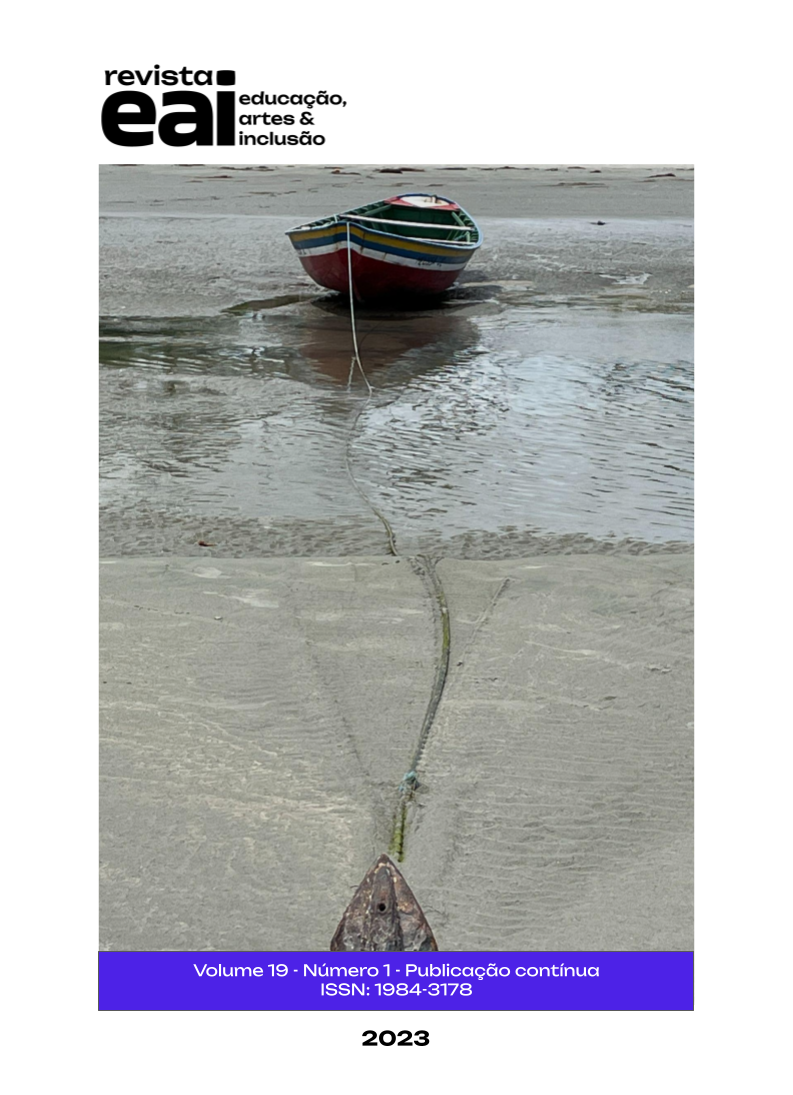Análise de dois métodos brasileiros para ensino coletivo de instrumentos de arco
DOI:
https://doi.org/10.5965/198431781820231e0039Palavras-chave:
ensino coletivo de instrumentos musicais, manuais ou métodos didáticos, educação musicalResumo
O artigo propõe-se a analisar dois métodos de ensino coletivo para instrumentos de arco. Nos últimos anos, vimos um crescimento significativo em relação à utilização e à pesquisa do ensino coletivo de instrumentos musicais em nosso país, mas quando o professor de cordas procura realizar seu trabalho tendo como suporte um método que utilize repertório brasileiro, encontra muitos problemas, pois existem poucas, ou nenhuma opção no mercado, que também não possui tradição na comercialização de materiais didáticos de música. Especificamente, a proposta foi realizar uma análise voltada às questões técnicas e culturais, que utilizou na coleta de dados o procedimento de notação orientada por guia e, na interpretação, organização e apresentação dos dados obtidos, a estatística descritiva e o processo de emparelhamento (Pattern Matching). Os dois métodos analisados nesse artigo podem contribuir para enriquecer o processo inicial de ensino de música, oferecendo uma boa opção para incluir o repertório brasileiro, formado por canções e temas folclóricos, na iniciação de alunos de violino, viola, violoncelo e contrabaixo.
Downloads
Referências
BARBOSA, Joel L. da S. Da capo: an adaptation of American band instruction methods to Brazilian music education, using Brazilian melodies. 1994. 267p. Tese (Doutorado em Artes Musicais) – University of Washington, Seattle, 1994.
BARBOSA, Joel L. da S. Da Capo: Instrumentos de arco. Método elementar para o ensino coletivo de instrumentos de arco (livro do professor - regência). 2011. 60p. Não publicado.
BARBOSA, Joel Luis da S. Prefácio. In: NASCIMENTO, Marco A. T.; STERVINOU, Adeline A. M. (org.). Ensino e aprendizagens musicais no mundo: formação, diversidade e currículo com ênfase na formação humana. Sobral: Sobral Ed., 2018, p. 13-17.
BRAZIL, Marcelo A. Leitura musical para iniciantes em aulas coletivas de violão: uma visão através da teoria da autoeficácia. 2017. 288p. Tese (Doutorado em Música - Educação Musical) – Universidade Federal da Bahia, Salvador, 2017.
FARIAS, Ulisses W. V. Memorial do Programa Cordas da Amazônia e sua contribuição cultural. 2009. 83p. Monografia (Licenciatura em Música) – Universidade Federal do Pará, Belém, 2009.
KRUGER, Linda L.; PEIXOTO, Anamaria. Iniciando cordas através do folclore: violino-viola-violoncelo-contrabaixo. Belém: Universitária UFPA, 1991. 201p.
PEIXOTO, Anamaria. Iniciando cordas através do folclore. Opus, Porto Alegre, v. 2, n.º 2, p. 15-20, jun. 1990.
ROMINGER, Laurie. Musicianship in Beginning Level String Pedagogy: A Content Analysis of Class Method Books. 2016. 112p. Tese (doutorado em Música) – Escola de Música, Universidade do Estado da Louisiana, Baton Rouge (LA), 2016.
SANTOS, Wilson R. Educação musical coletiva com instrumentos de arco: uma proposta de sistema em níveis didáticos. 2016. 498p. Tese (Doutorado em Música - Educação Musical) – Universidade Federal da Bahia, Salvador, 2016.
SANTOS, Wilson R. Situação e perspectivas da pesquisa sobre ensino coletivo de instrumentos no Brasil: uma análise do período compreendido entre 1990 e 2013. Revista Vórtex, Curitiba, v.7, n.º 3, p.1-26, 2019.
Downloads
Publicado
Como Citar
Edição
Seção
Licença
Copyright (c) 2023 Wilson Rogério Santos, Ana Roseli Paes dos Santos

Este trabalho está licenciado sob uma licença Creative Commons Attribution-NonCommercial-ShareAlike 4.0 International License.
A Revista Educação Artes e Inclusão é um periódico que segue a Política de Acesso Livre. Os artigos publicados pela revista são de uso gratuito, destinados a aplicações educacionais e não comerciais. Os artigos cujos autores são identificados representam a expressão do ponto de vista de seus autores e não a posição oficial da Revista Educação, Artes e Inclusão [REAI].
Autores que publicam nesta revista concordam com os seguintes termos:
(a) Autores mantém os direitos autorais e concedem à revista o direito de primeira publicação, com o trabalho simultaneamente licenciado sob a Licença Creative Commons Attribution que permite o compartilhamento do trabalho com reconhecimento da autoria e publicação inicial nesta revista.
(b) Autores têm autorização para assumir contratos adicionais separadamente, para distribuição não-exclusiva da versão do trabalho publicada nesta revista (ex.: publicar em repositório institucional ou como capítulo de livro), com reconhecimento de autoria e publicação inicial nesta revista.
(c) Esta revista proporciona acesso público a todo o seu conteúdo, uma vez que isso permite uma maior visibilidade e alcance dos artigos e resenhas publicados. Para maiores informações sobre esta abordagem, visite Public Knowledge Project.
Esta revista está licenciada com uma Licença Creative Commons Atribuição-NãoComercial 4.0 Internacional. Esta licença permite que outros remixem, adaptem e criem a partir do seu trabalho para fins não comerciais, e embora os novos trabalhos tenham de lhe atribuir o devido crédito e não possam ser usados para fins comerciais, os usuários não têm de licenciar esses trabalhos derivados sob os mesmos termos.





